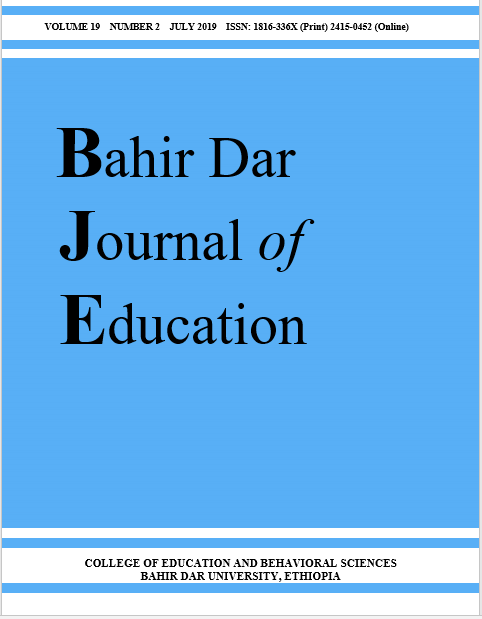The Current Status of Government Early Childhood Care and Education Programs in Bahir Dar City Administration
Abstract
This study examined the current status of some government Early Childhood Care and Education (ECCE) Programs in Bahir Dar city Administration. Qualitative research approach, specifically, evaluation research was employed. The Ethiopia Education Sector Development Program V (ESDP V) was used as evaluation framework. Ewuqet Fana, Atsie Sertse Dingle, Felg Abay and Quliqual Meda preschools were the research sites. The data were collected from six teachers and three directors using available sampling technique. Semi-structured interview, observation and document analysis were employed to collect the data. Inductive analysis was applied to identify themes and analyze the data. The finding revealed that in the study programs, various ECCE modalities are being implemented some of which are not indicated in ESDP-V framework; shortage of classrooms, lack of trained teachers, large class size, lack of child sized chair and table, absence of water and sanitation facilities, and lack of play materials are found to be the major challenges affecting the status of the programs; school directors perceived that their preschools are providing low quality services and strategies outlined in ESDP V are not properly implemented. Finally, it was concluded that though government ECCE programs expanded to address the need of children from disadvantaged groups, they are serving these children with low status and lots of limitations. Thus, it is recommended that the government should give much emphasis to the quality status of the programs, amend its policy strategies and directly involve in the construction of ECCE program.References
Amogne, A. E. (2015).The impact of attending pre-school education on later academic achievement of students: Empirical evidences from Dessie, Ethiopia. Basic Research Journal of Education Research and Review, 4(3), 72-80.
Federal Ministry of Education. (2010). Education sector development program IV (ESDP-IV) 2010/2011 – 2014/2015 (2003 EC – 2007 EC). Addis Ababa.
Federal Ministry of Education. (2015). Education sector development program V (ESDP-V) 2008-2012E.C(2015/2016 – 2019/2020 ). Addis Ababa.
Frost, J. L., Wortham, S. C., & Reifel, S.(2012). Play and child development (4th ed.). Boston: Pearson.
Green, S. (2002). BTEC national early years. United Kingdom: Nelson Thornes Ltd.
Gustafsson-Wright, E. , Gardiner, S., & Smith, K.(2016). Ensuring effective outcome-based Financing in early childhood development. The International Commission on Financing Global Education Opportunity. Retrieved from educationcommission.org
Hoot,J.L., Szente,J., & Mebratu, B. (2004). Early education in Ethiopia: progress and prospects. Early Childhood Education Journal, 32(1), 3-8.
Johnson, J.E., Chiristie, J.F., & Yawkey, T. D. (1999). Play and early childhood development (2nd ed.). New York: Longman.
Melese, A., & Kifle, K. (2017). Early Child Hood Care and Education (ECCE): Practices and Challenges, the Case of Woldia Town, North East Ethiopia. Global Journal of Human-Social Science: G Linguistics & Education, 17(9). Retrieved from https://globaljournals.org/GJHSS_Volume17/5-Early-Child-Hood-Care.pdf
Ministry of Education. (2005). Education sector development program III(ESDP-III). Addis Ababa.
Morrison, G. S.(2004). Early childhood education today (9th Ed.). Upper Saddle River: Merrill Prentice-Hall.
National Association for the Education of Young Children (2009). Developmentally appropriate practice in early childhood programs serving children from birth through age 8. Retrieved from https://www.naeyc.org>PDFs>PSDAP
National Association for the Education of Young Children. (2013). NAEYC accreditation. Retrieved from https://idahostars.org/portals/61/Docs/Providers/STQ/TeacherChildRatioChart.pdf
Mottee , S.L.(2014). The African union education outlook report: Early childhood development, A continental perspective. Retrieved from www.adeanet.org>system>files >au_e...
Santrock, J. W. (2011). Child development (13th ed.). New York: Mcgraw-Hill.
Tassoni, P., & Hucher,K. (2000). Planning play and the early years. UK: Heinemann Child Care
UNESCO & UNICEF (2012). Early childhood care and education. Retrieved from https://www.unicef.org.>eapro>end_D...
Woodhead, M. (2009). Pathways through early childhood education in Ethiopia, India and Peru: Rights, Equity and Diversity. UK: Young Lives.
Wortham, S.C. (2006). Early childhood curriculum: Developmental bases for learning and teaching (4th ed.). Upper Saddle River: Pearson Merrill Prentice Hall.
Yigzaw, H., & Abdirahman, M. (2017). Practices and challenges of public and private preschools of Jigjiga city administration. International Journal of Research - Granthaalayah, 5(12), 17-32. Retrieved from https://doi.org/10.5281/zenodo.1133562
Young Lives (2010). Early childhood care and education as a strategy for poverty reduction: evidence from Young life. Retrieved from http://www.Younglife.org.uk
Authors who publish with this journal agree to the following terms:
- Authors retain copyright and grant the journal right of first publication with the work simultaneously licensed under a Creative Commons Attribution License that allows others to share the work with an acknowledgement of the work's authorship and initial publication in this journal.
- Authors are able to enter into separate, additional contractual arrangements for the non-exclusive distribution of the journal's published version of the work (e.g., post it to an institutional repository or publish it in a book), with an acknowledgement of its initial publication in this journal.
- Authors are permitted and encouraged to post their work online (e.g., in institutional repositories or on their website) prior to and during the submission process, as it can lead to productive exchanges, as well as earlier and greater citation of published work (See The Effect of Open Access).

